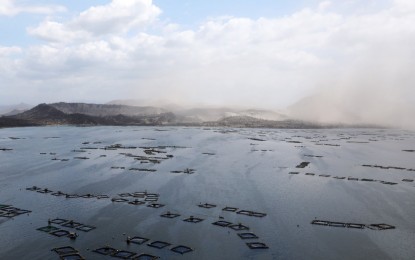
Fish cages in Taal Lake (PNA photo by Joey Razon)
MANILA -- The 3,000-strong Taal Lake Aquaculture Alliance, Inc. (TLAAI) is appealing to the government for sufficient "window hours" to feed and harvest thousands of tons of healthy, marketable fish still in their cages.
In a letter to Agriculture Secretary William Dar, Batangas Governor Hermilando Mandanas, and other ranking government officials involved in Taal’s rehabilitation, TLAAI reported that about 70 percent of their fish cages survived and are still floating despite Taal Volcano’s destructive eruption.
Before Taal’s eruption, the group said daily harvest from Taal Lake ranges from 120 to 150 tons of bangus (milkfish) and tilapia. Total fish production from the 6,000 cages of TLLAI members reaches more than 50,000 tons each year. Of this volume, about 60 percent is consumed in Batangas, Cavite, Laguna, and Quezon. The remaining 40 percent is sent to Metro Manila and sold through the Philippine Fisheries Development Authority (PFDA) Fishport Complex in Navotas City.
“Half of the surviving cages still have healthy living fish, but they need to be fed and fattened to maximize quality and value. We also need to repair our cages and start recovering and rebuilding whatever is left of our livelihood. These fish are our only chance to recover and sustain our 12,000 workers and their families,” the group said in a statement.
Aside from requesting window hours for qualified and capable personnel to feed, nurture and undertake emergency cage repairs within the seven-kilometer danger zone, the group also requested for the mobile office of the Bureau of Fish and Aquatic Resources (BFAR) and other local government units (LGUs) for the issuance of Auxiliary Invoice and Local Transport Permits to facilitate quick and efficient fish harvest.
TLAAI also asked BFAR and Philippine Coast Guard (PCG) for their presence and assistance to fisherfolk during the implementation of the window hours for fish feeding and harvesting within the said radius around Taal volcano.
They also requested the repair and rehabilitation of access roads to and from Taal Lake to facilitate quick delivery of fish harvest, feeds supply and urgent cage repairs, and for the issuance of Credit or Letters of Guarantee from DA-BFAR to feed producers so that fish farmers with insufficient funds can purchase feeds.
The group is also asking that they be included as member in the proposed Taal Lake Commission as representatives in the fisheries sector.
Since aquaculture and fishing are main contributors to the economy around Taal Lake, the group believes its members can share their experience, insights and well-grounded perspective on the real situation in Taal Lake.
BFAR earlier said fish from Taal Lake is safe for human consumption provided some conditions -- the fish must be fresh and washed thoroughly, with gills and internal organs properly removed and cooked thoroughly.
BFAR is also set to provide assorted fingerlings -- 7 million tilapia; 20,000 freshwater shrimps; 50,000 catfish; 100,000 bighead carp; and 5,000 ayungin to affected areas. (PR)
